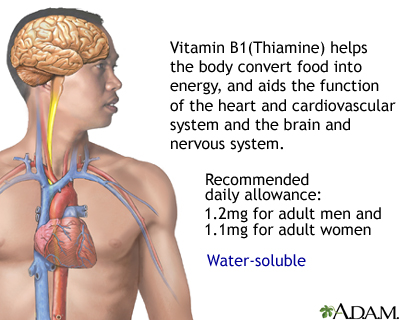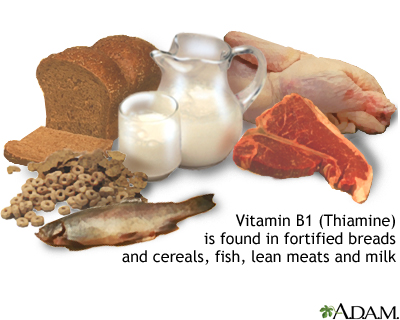Health Library
Thiamin
Vitamin B1; Thiamine
Thiamin is one of the B vitamins. The B vitamins are a group of water-soluble vitamins that are part of many of the chemical reactions in the body.
Images


I Would Like to Learn About:
Function
Thiamin (vitamin B1) helps the body's cells change carbohydrates into energy. The main role of carbohydrates is to provide energy for the body, especially the brain and nervous system.
Thiamin also plays a role in muscle contraction and conduction of nerve signals.
Thiamin is essential for the metabolism of pyruvate, which is an important molecule in several chemical reactions in the body.
Food Sources
Thiamin is found in:
- Enriched, fortified, and whole grain products such as bread, cereals, rice, pasta, and flour
- Wheat germ
- Beef steak and pork
- Trout and bluefin tuna
- Egg
- Legumes and peas
- Nuts and seeds
Dairy products, fruits, and vegetables are not very high in thiamin in small amounts. But when you eat large amounts of these, they become a significant source of thiamin.
Side Effects
A lack of thiamin can cause weakness, fatigue, psychosis, and nerve damage.
Thiamin deficiency in the United States is most often seen in people who abuse alcohol (alcoholism). A lot of alcohol makes it hard for the body to absorb thiamin from foods.
Unless those with alcoholism receive higher-than-normal amounts of thiamin to make up for the difference, the body will not get enough of the substance. This can lead to a disease called beriberi.
In severe thiamin deficiency, brain damage can occur. One type is called Korsakoff syndrome. The other is Wernicke disease. Either or both of these conditions can occur in the same person.
There is no known poisoning linked to excessive intake of thiamin.
Recommendations
Recommendations for thiamin, as well as other nutrients, are provided in the Dietary Reference Intakes (DRIs) developed by the Food and Nutrition Board at the National Academies of Sciences, Engineering, and Medicine. DRI is a term for a set of reference intakes that are used to plan and assess the nutrient intakes of healthy people. These values, which vary by age and sex, include:
Recommended Dietary Allowance (RDA): The average daily level of intake that is enough to meet the nutrient needs of nearly all (97% to 98%) healthy people. An RDA is an intake level based on scientific research evidence.
Adequate Intake (AI): This level is established when there is not enough scientific research evidence to develop an RDA. It is set at a level that is thought to ensure enough nutrition.
Dietary reference intakes for thiamin:
Infants (AI)
- 0 to 6 months: 0.2* milligrams per day (mg/day)
- 7 to 12 months: 0.3* mg/day
Children (RDA)
- 1 to 3 years: 0.5 mg/day
- 4 to 8 years: 0.6 mg/day
- 9 to 13 years: 0.9 mg/day
Adolescents and adults (RDA)
- Males age 14 and older: 1.2 mg/day
- Females age 14 to 18 years: 1.0 mg/day
- Females age 19 and older: 1.1 mg/day (1.4 mg needed during pregnancy and lactation)
The best way to get the daily requirement of essential vitamins is to eat a balanced diet that contains a variety of foods.
Related Information
CarbohydratesReferences
Koppel BS. Nutritional and alcohol-related neurologic disorders. In: Goldman L, Schafer AI, eds. Goldman-Cecil Medicine. 26th ed. Philadelphia, PA: Elsevier; 2020:chap 388.
La Charite J. Nutrition and growth. In: Kleinman K, Mcdaniel L, Molloy M, eds. The Harriet Lane Handbook. 22nd ed. Philadelphia, PA: Elsevier; 2021:chap 21.
Markell M, Siddiqi HA. Vitamins and trace elements. In: McPherson RA, Pincus MR, eds. Henry's Clinical Diagnosis and Management by Laboratory Methods. 24th ed. Philadelphia, PA: Elsevier; 2022:chap 27.
Sachdev HPS, Shah D. Vitamin B deficiencies and excess. In: Kliegman RM, St. Geme JW, Blum NJ, Shah SS, Tasker RC, Wilson KM, eds. Nelson Textbook of Pediatrics. 21st ed. Philadelphia, PA: Elsevier; 2020:chap 62.
BACK TO TOPReview Date: 3/11/2021
Reviewed By: Meagan Bridges, RD, University of Virginia Health System, Charlottesville, VA. Also reviewed by David Zieve, MD, MHA, Medical Director, Brenda Conaway, Editorial Director, and the A.D.A.M. Editorial team. Editorial update 09/29/2021.
 | A.D.A.M., Inc. is accredited by URAC, for Health Content Provider (www.urac.org). URAC's accreditation program is an independent audit to verify that A.D.A.M. follows rigorous standards of quality and accountability. A.D.A.M. is among the first to achieve this important distinction for online health information and services. Learn more about A.D.A.M.'s editorial policy, editorial process and privacy policy. A.D.A.M. is also a founding member of Hi-Ethics. This site complies with the HONcode standard for trustworthy health information: verify here. |
The information provided herein should not be used during any medical emergency or for the diagnosis or treatment of any medical condition. A licensed medical professional should be consulted for diagnosis and treatment of any and all medical conditions. Links to other sites are provided for information only -- they do not constitute endorsements of those other sites. © 1997- 2021 A.D.A.M., a business unit of Ebix, Inc. Any duplication or distribution of the information contained herein is strictly prohibited.
